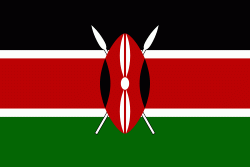Flag of Kenya
The Flag of Kenya (Bendera ya Kenya) is a tricolour of black, red, and green with two white edges imposed with a red, white and black Maasai shield and two crossed spears. The flag is based on that of Kenya African National Union and was officially adopted on 12 December 1963 after Kenya's independence.
The Kenyan flag is on the black over red over the green flag of Kenya African National Union (KANU), the political party that led the fight for the independence of Kenya. Upon independence, the white fimbriation, symbolising peace and unity, and the shield were added. The meaning of the colours of the flag of Kenya match closely to those of the Pan-African flag adopted by the Universal Negro Improvement Association and African Communities League in 1920.
The 2010 revised edition of the Constitution of Kenya includes specifications of the Kenyan flag, located in the Second schedule, Article 9, paragraph 6.2.
The Kenyan flag is on the black over red over the green flag of Kenya African National Union (KANU), the political party that led the fight for the independence of Kenya. Upon independence, the white fimbriation, symbolising peace and unity, and the shield were added. The meaning of the colours of the flag of Kenya match closely to those of the Pan-African flag adopted by the Universal Negro Improvement Association and African Communities League in 1920.
The 2010 revised edition of the Constitution of Kenya includes specifications of the Kenyan flag, located in the Second schedule, Article 9, paragraph 6.2.
National flag
Country - Kenya
Warning: getimagesize(/Image/Map/MP192950.gif): failed to open stream: No such file or directory in /home/mapnlee7/public_html/MAPNALL/article.php on line 532
 |
 |
Kenya's earliest inhabitants were hunter-gatherers, like the present-day Hadza people. According to archaeological dating of associated artifacts and skeletal material, Cushitic speakers first settled in Kenya's lowlands between 3,200 and 1,300 BC, a phase known as the Lowland Savanna Pastoral Neolithic. Nilotic-speaking pastoralists (ancestral to Kenya's Nilotic speakers) began migrating from present-day South Sudan into Kenya around 500 BC. Bantu people settled at the coast and the interior between 250 BC and 500 AD. European contact began in 1500 AD with the Portuguese Empire, and effective colonisation of Kenya began in the 19th century during the European exploration of the interior. Modern-day Kenya emerged from a protectorate established by the British Empire in 1895 and the subsequent Kenya Colony, which began in 1920. Numerous disputes between the UK and the colony led to the Mau Mau revolution, which began in 1952, and the declaration of independence in 1963. After independence, Kenya remained a member of the Commonwealth of Nations. The current constitution was adopted in 2010 and replaced the 1963 independence constitution.
